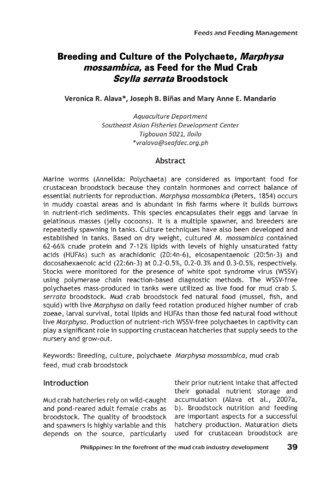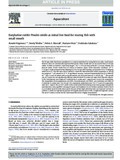Successful use of cryopreserved oyster trocophores as a live first feed larval marine fish and invertebrates
- Global styles
- MLA
- Vancouver
- Elsevier - Harvard
- APA
- Help

Date
1996Author
Page views
5,970ASFA keyword
diet 
growth rate
cultured organisms
mortality
warm-water aquaculture
feeds
marine invertebrates
spat
invertebrate larvae
molluscan larvae
seed production
fish larvae
aquarium culture
cold storage
thawing
feed composition
marine fish
rearing techniques
nutritive value
marine molluscs
mariculture
mortality causes
fish culture

growth rate

cultured organisms

mortality

warm-water aquaculture

feeds

marine invertebrates

spat

invertebrate larvae

molluscan larvae

seed production

fish larvae

aquarium culture

cold storage

thawing

feed composition

marine fish

rearing techniques

nutritive value

marine molluscs

mariculture

mortality causes

fish culture

AGROVOC keyword
Metadata
Show full item recordShare
Abstract
Trochophore-stage larvae of the Pacific oyster Crassostrea gigas were cryopreserved in bulk and stored in liquid nitrogen for periods up to two years before thawing and feeding to a variety of warmwater and coldwater larval marine fish, as well as to marine shrimps and other invertebrates. The commercial product ("TrochoFeed"), marketed in both pre-thawed and cryopreserved versions, has been used successfully in the early rearing of cultured species including red drum, snook, grouper, and black cod, as well as for numerous warmwater and coldwater aquarium display fish.
This paper describes the nutritional profile of the cryopreserved trochopores and presents a summary of the available growth and mortality data.
Suggested Citation
Harvey, B. J. (1996). Successful use of cryopreserved oyster trocophores as a live first feed larval marine fish and invertebrates. In C. L. Marte, G. F. Quinitio, & A. C. Emata (Eds.), Proceedings of the Seminar-Workshop on Breeding and Seed Production of Cultured Finfishes in the Philippines, Tigbauan, Iloilo, Philippines, 4-5 May 1993 (pp. 166-169). Tigbauan, Iloilo, Philippines: Aquaculture Department, Southeast Asian Fisheries Development Center.
Type
Conference paperISBN
9718511326
Related items
Showing items related by title, author, creator and subject.
-
Breeding and culture of the polychaete, Marphysa mossambica, as feed for the mud crab
Alava, Veronica R.; Biñas, Joseph B.; Mandario, Mary Anne (Aquaculture Department, Southeast Asian Fisheries Development Center, 2017)
Marine worms (Annelida: Polychaeta) are considered as important food for crustacean broodstock because they contain hormones and correct balance of essential nutrients for reproduction. Marphysa mossambica (Peters, 1854) ...
(Aquaculture Department, Southeast Asian Fisheries Development Center, 2017)
Marine worms (Annelida: Polychaeta) are considered as important food for crustacean broodstock because they contain hormones and correct balance of essential nutrients for reproduction. Marphysa mossambica (Peters, 1854) ... -
Euryhaline rotifer Proales similis as initial live food for rearing fish with small mouth
Hagiwara, Atsushi; Wullur, Stenly; Marcial, Helen S.; Hirai, Narisato; Sakakura, Yoshitaka (Elsevier, 2014)The SS-type rotifer Brachionus rotundiformis is a common initial food for rearing fish larvae with a small mouth. However, there are commercially important fish species whose mouth sizes are too small to feed on ...
-
Growth and survival of grouper Epinephelus coioides (Hamilton) larvae fed free-living nematode Panagrellus redivivus at first feeding
Reyes, Ofelia S.; Duray, Marietta N.; Santiago, Corazon B.; Ricci, Manuele (European Aquaculture Society, 2011)The free-living nematode, Panagrellus redivivus, was tested as live food for grouper Epinephelus coioides larvae during the first feeding stage. A series of experiments were conducted to determine the acceptability of the ...




